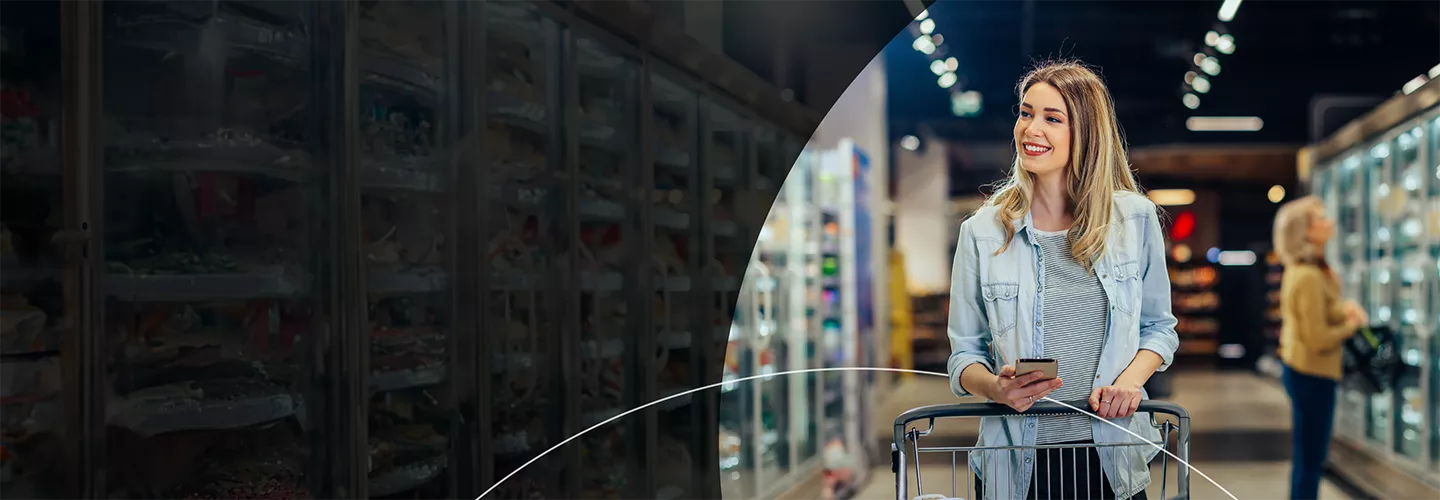By: Matthew Piazza
Published: September 18, 2024 | Updated: October 10, 2024
Read time: 5 minutes

Introduction
Omnichannel sales are the new reality for CPG brands. Today’s consumers are searching for simple, secure and seamless shopping experiences. It’s no longer a preference, but an expectation.
This shift towards omnichannel shopping has transformed the consumer goods industry. For many, long trips to the store to browse for dozens of items are now a thing of the past. Today’s consumers want a quick and easy way to meet their day-to-day needs, from restocking toilet paper and cosmetic products to buying their weekly grocery supplies.
Making life easier for consumers means removing as much friction in the shopping experience as possible. CPGs are focused on providing relevant product recommendations, offering the right promotions at the right times and expanding options for retail partners’ delivery and in-store pickup programs.
However, omnichannel sales can come with its fair share of challenges. CPGs must manage a growing number of distribution channels, like direct sales and new digital marketplaces, while ensuring consistency across all channels and touchpoints. Operating across more channels will also require increased sophistication and efficiency in distribution and network operations.
4 best practices for omnichannel CPGs
Cracking the code on omnichannel sales can be challenging. As brands build out their strategies, they can learn from companies like PepsiCo that have launched and scaled global omnichannel programs.
In a webinar hosted by the Consumer Brands Association, Athina Kanioura, Chief Strategy and Transformation Officer at PepsiCo, joined us for a fireside chat. Our conversation touched on the evolution of omnichannel shopping in the CPG industry and future trends and predictions.
Interested in refining your omnichannel marketing strategy? Here are four of PepsiCo’s best practices to consider implementing:
1. Keep consumers at the core
A solid understanding of consumer needs is one of the building blocks of a successful omnichannel marketing strategy, and it often starts with data.
Create a holistic view of consumer behavior by gathering and integrating insights from various sources, like in-store and online sales, loyalty program data and social and online engagement. Carefully analyze sales and transaction patterns to identify consumers’ preferred channels and tailor interactions accordingly. Today’s consumers expect hyper-personalized messaging, so a complete view of their tastes and habits will be essential for offering the right discounts and recommendations.
PepsiCo launched its omnichannel strategy several years ago in response to consumer demand. To build out its omnichannel ecosystem, PepsiCo made investments in its talent and analytical infrastructure. Over the years, they built a global consumer data platform to help better analyze consumer trends and improve touchpoints across the lifecycle. The data platform also helps PepsiCo stay in tune with consumer preferences and inform product development and sustainability initiatives across the business.
2. Evaluate the risks of expanding into omnichannel
Investing in online channels, like direct-to-consumer sales and partnerships with delivery services, is an important step in launching an omnichannel strategy. However, the increased focus on digital comes with its own set of considerations.
Omnichannel commerce can pose challenges for data privacy and cybersecurity, for instance. As you aggregate more consumer insights, ensure you have the right safeguards in place to protect your data and systems. Brands will benefit from tools and platforms that help identify online threats and risks. Be sure also to consider the broader regulatory environment and the implications of new omnichannel tactics.
PepsiCo navigates this challenge by examining the regulations of each market in which it conducts sales and ensuring its privacy practices are compliant. Different global markets can have very different laws, so transparent and compliant data practices are a must. Implementing transparent practices and managing data with integrity will also help build consumer trust.
3. Build out the supplier-retailer ecosystem
CPGs are building new partnerships, platforms and business models to reach consumers on different channels.
Online marketplaces and delivery services are key players in the omnichannel landscape and can help CPGs extend their reach and get their products in front of shoppers more easily and often. CPGs can also work closely with delivery partners to introduce exclusive discounts or product bundles.
Retailers are another key player in this ecosystem. Expanding relationships with grocers, drugstores and convenience chains can help get products promoted on both online and in-store retail channels. Investing in retailers’ media networks will also be critical for omnichannel marketing efforts. Half of CPGs globally are investing in four or more retail media networks, and many plan to scale up their investments. Through leveraging retailers’ consumer data and ad networks, CPGs can better personalize touchpoints and maximize their marketing budgets.
CPGs can also continue developing their own channels for reaching consumers, like subscription services and loyalty programs. PepsiCo, for example, is exploring channels like social commerce and direct-to-consumer to expand their reach and offer differentiated consumer experiences.
Strengthening the direct-to-consumer relationship will drive repeat purchases and foster long-term brand loyalty.
4. Consider supply chain implications
One of the benefits of omnichannel sales is increasing convenience for consumers. However, expanding into omnichannel can make things more complex and perhaps less convenient operationally.
As one example, omnichannel sales make order fulfillment more complicated. Manufacturers must now deliver more products across more channels, and each channel has its own service requirements and cost structure. To manage costs and maximize efficiency, CPGs can proactively consider the implications of omnichannel sales and develop a strategy to adjust inventory across the network.
During PepsiCo’s journey, their team redesigned aspects of the supply network to scale omnichannel efforts. They accounted for different considerations — like the fact that consumers were ordering on-demand more, meaning products would need to move more quickly — and enhanced the supply chain process accordingly.
Conclusion
Delivering a seamless omnichannel shopping experience will continue to be a decisive differentiator for CPG companies. To win with today’s savvy shoppers, brands will need a robust understanding of consumer behavior across the different sales channels. The key to success will be having the right capabilities to deliver personalized campaigns, measure cross-channel impact and streamline order fulfillment.
Watch the on-demand webinar to hear how PepsiCo transformed its omnichannel sales strategy and learn how partnering with Mastercard can help.















